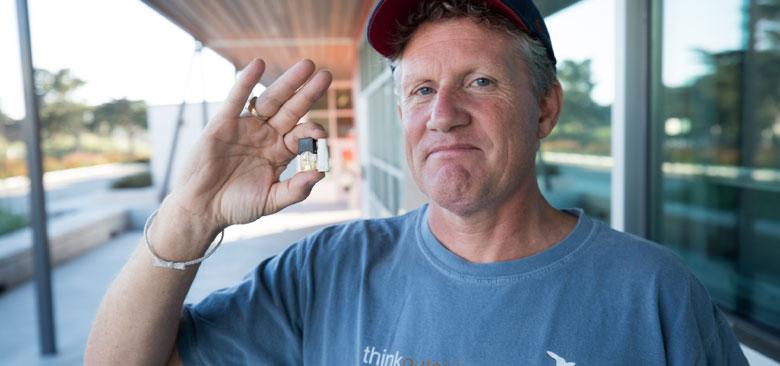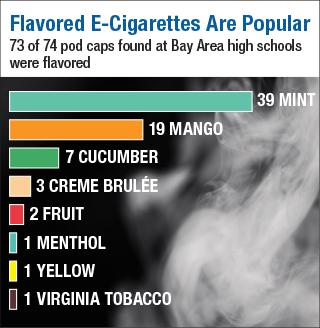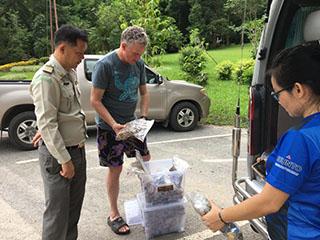
UCSF associate professor Jeremiah Mock holding a JUUL e-cigarette cartridge and a cigarette butt he found on a local high school campus (photo by Elisabeth Fall)
How E-Cigarette Use is Exposing Youth — and the Environment — to Toxic Chemicals
The use of electronic cigarettes, or e-cigarettes, by American youth has surged so dramatically in recent years that the U.S. Surgeon General has declared it an “epidemic.” According to the Centers for Disease Control and Prevention, e-cigarette use among middle school students increased by 48 percent (3.3 percent to 4.9 percent) and among high school students by 78 percent (11.7 percent to 20.8 percent) from 2017 to 2018. In 2018, about 3.6 million middle and high school students nationwide reported using e-cigarettes, according to the CDC.

Communities in the San Francisco Bay Area have not been immune to this epidemic. For example, in Marin County between 2016 and 2018, e-cigarette use among seventh-graders rose from 2 percent to 5 percent, and among 11th-graders from 11 percent to 28 percent, according to the California Healthy Kids Survey.
JUUL is the leader in the e-cigarette industry with a market share around 70 percent.
“A year ago, there were very few high school administrators and parents in Marin County who knew what JUUL was or how to pronounce it,” said Jeremiah Mock, a health anthropologist and associate professor in the UC San Francisco School of Nursing’s Institute for Health & Aging and member of UCSF’s Center for Tobacco Control Research and Education. “JUULing caught a large majority of parents and teachers flat-footed.”
In addition, the waste from e-cigarettes may pose negative environmental effects. Mock and other researchers at UCSF are investigating this potential risk, which has taken them from the parking lots of San Francisco Bay Area high schools to the beaches and national parks of the Pacific Rim.
12 High Schools, 893 Pieces of Tobacco Waste
First introduced in the U.S. in 2007, e-cigarettes were hailed by some as a healthier alternative to combustible cigarettes because users avoided inhaling some of the estimated 7,000 chemicals that are produced from burning tobacco.
But e-cigarettes, notably JUUL, have become increasingly popular with adolescents and teens — and with considerable dangers. Emerging evidence shows that the use of e-cigarettes can cause heart attacks, lung disease, and may cause seizures. E-cigarette aerosol can also contain cancer-causing chemicals, according to the American Cancer Society. Additionally, e-cigarettes contain nicotine, which is more damaging for younger users because brain development continues into one’s mid-20s. Studies have shown nicotine affects cell activity in the brain and negatively impacts the capacities for attention, learning and memory.
JUUL’s meteoric rise and Mock’s involvement with the Smoke-free Marin Coalition and Marin Healthy Youth Partnerships, motivated him to investigate the extent of e-  Yogi Hendlin, research associate at UCSF's Environmental Health Initiative. cigarette and other tobacco product waste at 12 Bay Area high schools. Mock and Yogi Hendlin, a research associate at UCSF’s Environmental Health Initiative, joined by Gia Asher, a former environmental leadership student at San Rafael’s Terra Linda High School, scoured the campuses over 10 months from 2018 to 2019 to see how much and what types of tobacco waste they would find.
Yogi Hendlin, research associate at UCSF's Environmental Health Initiative. cigarette and other tobacco product waste at 12 Bay Area high schools. Mock and Yogi Hendlin, a research associate at UCSF’s Environmental Health Initiative, joined by Gia Asher, a former environmental leadership student at San Rafael’s Terra Linda High School, scoured the campuses over 10 months from 2018 to 2019 to see how much and what types of tobacco waste they would find.
They collected 893 waste items, of which 19 percent was e-cigarette waste. Mock said the amount of flavored e-cigarette products found was “alarming.” Seventy-three of the 74 JUUL/JUUL compatible pod caps collected were from flavored pods, some with appealing names such as Fruit Medley, Crème Brulee and Cool Mint.
 “The flavors are really important,” Mock said. “When you look at the food, candy or soft drink industries, they know kids are attracted to flavors. So, it’s no surprise that kids would find it more appealing to use flavored products when it comes to e-cigarette use.”
“The flavors are really important,” Mock said. “When you look at the food, candy or soft drink industries, they know kids are attracted to flavors. So, it’s no surprise that kids would find it more appealing to use flavored products when it comes to e-cigarette use.”
Their findings also uncovered differences among students from various income and ethnic backgrounds. Eighty-eight percent of the e-cigarette waste collected – almost entirely JUUL/JUUL compatible products – was found at schools serving predominantly upper-income families with mostly white student populations. Of the conventional tobacco waste – cigarettes, little cigars and cigarillos – 67 percent were found at schools serving predominantly low- and middle-income families with large Latinx and African American populations. Mock said almost no e-cigarette waste was found at those schools.
While the e-cigarette epidemic has garnered national attention, Mock stresses youth use of other flavored tobacco products is under-reported and may be an emerging parallel epidemic, particularly in low-income African American and Latinx populations. He cautions that the disparity between e-cigarette and flavored tobacco use may not solely be an issue of income and ethnicity, and more research is needed.
Potential Toll on the Environment
E-cigarettes may produce another significant problem: environmental damage. Take JUUL, for example. Smoking a JUUL e-cigarette involves a lithium-ion battery-powered aerosolizer – resembling a metallic USB flash drive – and a pod filled with nicotine, various chemicals and artificial flavorings. When the pod is inserted into the aerosolizer, the pod’s liquid is heated by a metal coil, producing an aerosol that the user inhales.
“Their electronics are much more similar to your smartphone than a conventional cigarette,” Hendlin said.
If a discarded pod enters a storm drain, the plastic components break down into microplastics and nicotine residues can leach into water and soil. The electronics in discarded aerosolizers corrode and leach heavy metals, and can eventually find its way into a nearby river, bay or ocean.
E-cigarette components may release endocrine disruptive chemicals (EDC), Hendlin said. According to the World Health Organization, EDCs are believed to be linked to “altered reproductive function in males and females; increased incidences of breast cancer, abnormal growth patterns and neurodevelopmental delays in children,” among other negative effects. Hendlin said more research is necessary to determine if EDCs are in fact present in e-cigarette waste, and, if so, which types.
Lithium ion batteries can enlarge and explode when exposed to rain. They are also a significant fire hazard, Mock said, and have been linked to major fires at recycling centers.
“These products are becoming popular and widely used among adolescents, and they are creating a toxic waste stream,” Mock said. “And it’s not a trivial amount of waste. We are talking about billions of e-cigarette waste items each year.”
First-of-its-Kind Study Explores Impact of Tobacco Waste in Japan and Thailand
 Mock collecting tobacco waste in Thailand (photo courtesy of Jeremiah Mock) Mock, supported by a grant from the California Tobacco-Related Disease Research Program, is adding an international component to his research. He’s teamed with Stella Bialous, an associate professor in the School of Nursing; Pamela Ling, a professor at UCSF’s School of Medicine; and with researchers in California, Japan and Thailand, to develop new policy approaches to eliminating tobacco use in the great outdoors. They are examining tobacco industry strategies and advertising, as well as policies and tobacco use patterns at state and national parks, historic monuments and beaches in California and Asia.
Mock collecting tobacco waste in Thailand (photo courtesy of Jeremiah Mock) Mock, supported by a grant from the California Tobacco-Related Disease Research Program, is adding an international component to his research. He’s teamed with Stella Bialous, an associate professor in the School of Nursing; Pamela Ling, a professor at UCSF’s School of Medicine; and with researchers in California, Japan and Thailand, to develop new policy approaches to eliminating tobacco use in the great outdoors. They are examining tobacco industry strategies and advertising, as well as policies and tobacco use patterns at state and national parks, historic monuments and beaches in California and Asia.
It is the first study of its kind, Mock said, that looks comparatively at cultural patterns of tobacco use in the outdoors, including secondhand smoke exposures, tobacco waste contamination, and policy enforcement and compliance.
Japan and Thailand provide interesting comparison cases because of the legislative actions those countries have taken involving tobacco use. Japan has banned outdoor smoking in certain segments of Tokyo since 2002. Thailand banned smoking on 24 beaches in 2018.
A key focus for the researchers will be examining why smoking and e-cigarette use in the great outdoors is considered acceptable by many, despite the detrimental health and environmental effects.
“People who are older remember when you could smoke in bars and restaurants and would not hesitate to light a cigarette in somebody’s house,” said Bialous, who  Stella Bialous, associate professor, has consulted with the World Health Organization's Tobacco Free Initiative for over 15 years. works closely with UCSF’s Center for Tobacco Control Research and Education. “The younger generation wouldn’t think to walk into a restaurant and smoke or use tobacco because it’s been denormalized. We’re trying to assess whether this has been extended [to the great outdoors].”
Stella Bialous, associate professor, has consulted with the World Health Organization's Tobacco Free Initiative for over 15 years. works closely with UCSF’s Center for Tobacco Control Research and Education. “The younger generation wouldn’t think to walk into a restaurant and smoke or use tobacco because it’s been denormalized. We’re trying to assess whether this has been extended [to the great outdoors].”
Their findings could support strategies that legislative bodies could use to change this societal norm. In California, two complementary bills — SB-8 and AB 1718 — that would ban tobacco use at state parks and beaches are working their way through the state Senate and Assembly. Mock submitted a report based on his fieldwork in California state parks and beaches to the offices of Senator Steve Glazer and Assemblyman Marc Levine, who are sponsoring the bills.
“Ultimately, the solution is to get people to quit smoking and quit using e-cigarettes entirely, and to prevent young people from starting to use these products,” Mock said. “We want to shift people’s thinking so that they no longer see the great outdoors as the last refuge for smokers and e-cigarette users.”
To support Jeremiah Mock's research on youth tobacco use, visit https://givingtogether.ucsf.edu/fundraiser/2243625



